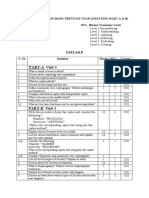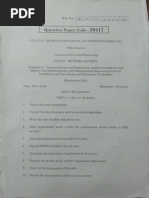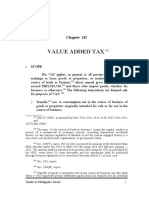0 ratings0% found this document useful (0 votes)
7 viewsFir Cat 1 Questions
Fir Cat 1 Questions
Uploaded by
5033 - John Jabes .JCopyright:
© All Rights Reserved
Available Formats
Download as PDF, TXT or read online from Scribd
Fir Cat 1 Questions
Fir Cat 1 Questions
Uploaded by
5033 - John Jabes .J0 ratings0% found this document useful (0 votes)
7 views3 pagesCopyright
© © All Rights Reserved
Available Formats
PDF, TXT or read online from Scribd
Share this document
Did you find this document useful?
Is this content inappropriate?
Copyright:
© All Rights Reserved
Available Formats
Download as PDF, TXT or read online from Scribd
Download as pdf or txt
0 ratings0% found this document useful (0 votes)
7 views3 pagesFir Cat 1 Questions
Fir Cat 1 Questions
Uploaded by
5033 - John Jabes .JCopyright:
© All Rights Reserved
Available Formats
Download as PDF, TXT or read online from Scribd
Download as pdf or txt
You are on page 1of 3
Reg.
No: olSo9 3
Question Paper Code: 1911TE804T
B.E/ B.Tech DEGREE CONTINUOUSASSESSMENT TEST-I, February. 2024
Eighth Semester
Department of Information Technology
191/TE804T - Forensics and Incident Response
Regulations 2019
Time: 90 minutes Maximum: 50Marks
Course Outcomes: The Student will be able to
CO1: Apply the basics of computer forensics and its terminologies using protocols.
CO2: Analyze the security issues in network and transport layer by firewalls.
CO3: Build Cyber Forensics technique to find the digital forensics.
C04: Evaluate the units and network traffic using forensics tools.
CO5: Compare and validate forensics data in cyber security.
CO6: Bvaluate the Investigations techniques to handle ethical issues.
K1 - Remember K2 -Understand K3 - Apply K4- Analyse K5 - Evaluate K6 - Create
Answer ALL Questions.
PART A-(10x 1=10 marks)
In tunnel mode, IPSec protects the.
a) Entire IP packet CO1 KI
1. b) IP header
c) IP payload
d) IP trailer
IKE uses
a) SKEMA CO1 K2
2 b) Oakley
c) ISAKMS
d) No key
SSL primarily focuses on
a) integrity and authenticity CO1 KI
3 b) integrity and non-repudiation
) authenticity and privacy
d) confidentiality and integrity
ESP does not provide
a) source authentication
4. b) data integrity CO1 K1
c) privacy
d) error control
In the layer of 0SImodcl, packet filtering firewalls are implemented
a) Application layer
5. b) Session layer CO2 K1
c) Presentation layer
d) Network layer
What is the key size allowed in PGP?
a) 1024-1056
6 b) 1024-4056 CO2 K2
c) 1024.4096
d) 1024-2048
SET stands for.
a) set Ecommerce transaction
7. b) secure Ecommerce transaction CO2 K1
c) set electronics transaction
d) secure electronic transaction
Network administrators can create their own ACL rules based on
and
a) Address, Protocols and Packet attributes
8 CO2 K2
b) Address, Protocols and security policies
c) Address, policies and Packet attributes
d) Network topology, Protocols and data packets
Damaging or destroying data rather than stealing is called as
a) Piracy
9 b) DOS attack CO3 K1
c) Phishing
d) Computer Vandalism
Any program or procedure that makes unauthorized actions is called
a) Threat
10. b) Malicious Code CO3 Ki
c) Denial-of-Service
d) Attack
PART B (5 x 2 =10 marks)
11. What is Cryptographic computation?
C01 K
12. Differentiate tunnel mode and transport mode in IP security? COI
13. Outline the general format for PGP message? CO2 K2
14. Sketch the header fields define in MIME? C02
K3
15. Define the term "Computer Forensics". CO3
PART C-(3x 10 =30 marks)
Compulsory Question
Could you provide a detailed explanation of the fundamental components
16. comprising the Transport Layer Security (TLS) protocol? Elaborate on each
component's role and functionality, emphasizing how they collectively contribute CO1 K4
to establishing secure communication over the internet.
Answer any 2 of the following questions
17. Formulate and design the operations involved in Encapsulating security payload
and Authentication header. CO1 K3
Imagine you're conducting an online purchase using Secure Electronic
18. Transactions (SET). Walk me through the process of how dual signature CO2 K4
creation and verification occur in this scenario.
Elaborate the concepts of identity theft and identity fraud, highlighting their
distinctions and potential impacts on individuals and organizations?
19. Additionally, could you provide insights into the role of Incident Response (IR) CO3 K4
toolkits in mitigating and managing the aftermath of identity-related cyber
incidents?
You might also like
- 191IT623 - Internet of Things - Unit 1 QBDocument3 pages191IT623 - Internet of Things - Unit 1 QBprakash S100% (1)
- Cyber Security Question BankDocument14 pagesCyber Security Question BankKalaiselvi TNo ratings yet
- CISSP Exam Prep Questions, Answers & Explanations: 1500+ CISSP Practice Questions with SolutionsFrom EverandCISSP Exam Prep Questions, Answers & Explanations: 1500+ CISSP Practice Questions with SolutionsRating: 3 out of 5 stars3/5 (7)
- IAE-2 QP - SET-BDocument3 pagesIAE-2 QP - SET-BSakthivelNo ratings yet
- (With Ans) IoT - MCQ Full UnitDocument21 pages(With Ans) IoT - MCQ Full Unitprakash S100% (2)
- CN PreparatoryDocument2 pagesCN PreparatoryNithyasri ANo ratings yet
- Question & Key Set ADocument8 pagesQuestion & Key Set ASri GayuNo ratings yet
- B.E/B.Tech - Unit Test Iii ExaminationDocument2 pagesB.E/B.Tech - Unit Test Iii ExaminationsharmilaNo ratings yet
- Cns QPDocument2 pagesCns QPsridharchandrasekarNo ratings yet
- 191BM545 PoTDocument4 pages191BM545 PoTprakash SNo ratings yet
- Question Paper ccs354Document3 pagesQuestion Paper ccs354astronaut982003100% (1)
- set 1Document1 pageset 1SANJAY AATHARSHNo ratings yet
- Fir Cat 2 QuestionsDocument3 pagesFir Cat 2 Questions5033 - John Jabes .JNo ratings yet
- CIA_1 Computer Networks 2 (1)Document1 pageCIA_1 Computer Networks 2 (1)santhini.tNo ratings yet
- Btech NC 3 Sem Computer System Security knc301 2021Document1 pageBtech NC 3 Sem Computer System Security knc301 2021sahuji17082004No ratings yet
- EthicalHackingQBDocument17 pagesEthicalHackingQBchavvaanithareddy18No ratings yet
- CSC315 356 144-CSC315Document5 pagesCSC315 356 144-CSC315Aniket AmbekarNo ratings yet
- IoT FOR COMMUNICATION ECEN 3232 - 2022Document4 pagesIoT FOR COMMUNICATION ECEN 3232 - 2022mayur.81926No ratings yet
- UNIT IDocument3 pagesUNIT IJobiNo ratings yet
- PYQDocument44 pagesPYQameer.amarteyNo ratings yet
- DIS Assignment Question PaperDocument1 pageDIS Assignment Question PaperJobiNo ratings yet
- IS Answer keyDocument16 pagesIS Answer keySanthiya S cseNo ratings yet
- Cie - Set 2Document2 pagesCie - Set 2marthandanTNo ratings yet
- Is Question BankDocument4 pagesIs Question BankShaik UbedNo ratings yet
- QP16 Network SecurityDocument2 pagesQP16 Network SecurityreshmapdscemailboxNo ratings yet
- 18CBC305J - Information Security QPDocument2 pages18CBC305J - Information Security QPdeepanvishalmayeleriNo ratings yet
- Network Tech - M.E IAT 1Document2 pagesNetwork Tech - M.E IAT 1shshhshsajsjsjsjNo ratings yet
- DPS PYQsDocument11 pagesDPS PYQsbhatshriya20No ratings yet
- CSC401_Intoduction to IOT and Its Security (1)Document3 pagesCSC401_Intoduction to IOT and Its Security (1)Apex ShamshNo ratings yet
- Retest QPDocument4 pagesRetest QPmithrak554No ratings yet
- Computer Networks QBDocument28 pagesComputer Networks QBmsk.official321No ratings yet
- Ramrao Adik Institute of Technology, NerulDocument2 pagesRamrao Adik Institute of Technology, NerulAditya ShahNo ratings yet
- Assignment - 1Document6 pagesAssignment - 1Nithyasri ANo ratings yet
- CA1 REVISION Question PaperDocument2 pagesCA1 REVISION Question PaperNARAYANANNo ratings yet
- CNS - Unit-3Document90 pagesCNS - Unit-3madamanchisathwikNo ratings yet
- IOT Model PaperDocument5 pagesIOT Model Papergowdapuspa2003No ratings yet
- Computer NetworkingDocument9 pagesComputer NetworkingCollins OchiengNo ratings yet
- Class Test 1Document3 pagesClass Test 1Magi100% (1)
- NS Summer 16Document1 pageNS Summer 1624210134No ratings yet
- IV-I-Reg-NETWORK SECURITY & CRYPTOGRAPHYDocument2 pagesIV-I-Reg-NETWORK SECURITY & CRYPTOGRAPHYbodhu varunNo ratings yet
- Iota Mid2 Cse, CSMDocument2 pagesIota Mid2 Cse, CSMNiharika NiharikaNo ratings yet
- CNS-21IS71-Tutorial3Document1 pageCNS-21IS71-Tutorial3varshithas366No ratings yet
- 4G 5G model newDocument2 pages4G 5G model newyasminbrandsNo ratings yet
- Bis IndexDocument1 pageBis IndexAamir ShaikhNo ratings yet
- CIA 1_CNF_Set2QPDocument2 pagesCIA 1_CNF_Set2QPpriya jNo ratings yet
- TiruvannamalaiDocument2 pagesTiruvannamalai5014 Manoraj pNo ratings yet
- Peii Iot QBDocument85 pagesPeii Iot QBAAKASH CSNo ratings yet
- Bis 70 Marks Model PaperDocument2 pagesBis 70 Marks Model PaperSachin MaruNo ratings yet
- 19ucs519-Cyber Security Aided EseDocument2 pages19ucs519-Cyber Security Aided EseAKHIL KRISHNA ANo ratings yet
- Ese - Dec2020 - Socs - B Tech Cse CCVT - Sem V - CSVT3008 - Cloud Security & ManagementDocument2 pagesEse - Dec2020 - Socs - B Tech Cse CCVT - Sem V - CSVT3008 - Cloud Security & ManagementharixNo ratings yet
- Cryptography SEE 2018Document2 pagesCryptography SEE 2018Darshan.B.C YadavNo ratings yet
- Question Bank Data Security Module I II IIIDocument5 pagesQuestion Bank Data Security Module I II IIImanoj mlpNo ratings yet
- Computer NetworksDocument3 pagesComputer Networksxyz86538No ratings yet
- CT-1Document1 pageCT-1monishsahu03No ratings yet
- Network Security QPDocument2 pagesNetwork Security QPhell hackerNo ratings yet
- Answer ALL Questions: PART B (5 X 16 80)Document17 pagesAnswer ALL Questions: PART B (5 X 16 80)Ahmed Eid Abd ElRaoufNo ratings yet
- AD HOC NETWORKS AND SECURITY-ECEN 4144-2022Document4 pagesAD HOC NETWORKS AND SECURITY-ECEN 4144-2022mousumisinha7070No ratings yet
- 22620-Sample-Question-Paper (Msbte Study Resources)Document4 pages22620-Sample-Question-Paper (Msbte Study Resources)asha50% (2)
- Sample Question Paper (Msbte Study Resources)Document4 pagesSample Question Paper (Msbte Study Resources)Gourav PandeyNo ratings yet
- Practice With MT - ROEDocument5 pagesPractice With MT - ROEkedapa9274No ratings yet
- Niccolo Machiavelli'Document5 pagesNiccolo Machiavelli'Gaurav TripathiNo ratings yet
- Chapter 3, Sec.5: Divisible and Indivisible ObligationsDocument4 pagesChapter 3, Sec.5: Divisible and Indivisible ObligationsRachel Jane TanNo ratings yet
- Case Studies in Islamic Banking and FinanceDocument2 pagesCase Studies in Islamic Banking and FinanceMahfuz An-NurNo ratings yet
- Sexual Orientation Gender Identity and Expression Sex CharacteristicsDocument80 pagesSexual Orientation Gender Identity and Expression Sex CharacteristicsCalapati, Jhon Rovic R.No ratings yet
- Cyber Risk InsuranceDocument8 pagesCyber Risk InsuranceJOHN NDIRANGUNo ratings yet
- TSUBL INV SpecificationDocument274 pagesTSUBL INV Specificationsensor_versionNo ratings yet
- RFBT 3302 ContractsDocument8 pagesRFBT 3302 ContractsAether SkywardNo ratings yet
- Labor Bar QDocument37 pagesLabor Bar QHemsley Gup-ayNo ratings yet
- Cartoon AnalysisDocument6 pagesCartoon AnalysisJasmin ArellanoNo ratings yet
- Ra-112854 Master Plumber Lucena 2-2024Document5 pagesRa-112854 Master Plumber Lucena 2-2024joseph john durolfoNo ratings yet
- BC557 TranzistorDocument9 pagesBC557 TranzistorjellaiNo ratings yet
- Question Bank Ashoka The Great: Knowledge Based Questions Fill in The BlanksDocument5 pagesQuestion Bank Ashoka The Great: Knowledge Based Questions Fill in The BlanksSaswati DashNo ratings yet
- CH 1 Auditing and Internal ControlDocument20 pagesCH 1 Auditing and Internal Controlangelica valenzuelaNo ratings yet
- Statcon Counter ArgumentDocument7 pagesStatcon Counter Argumentsslo roces2No ratings yet
- C&D Zodiac v. B/E Aerospace - Final Decision (PGR)Document39 pagesC&D Zodiac v. B/E Aerospace - Final Decision (PGR)Sarah BursteinNo ratings yet
- TMEMS Best Practice GuideDocument88 pagesTMEMS Best Practice GuideNelson MacedoNo ratings yet
- Extinguishment of Obligation Final ExamDocument4 pagesExtinguishment of Obligation Final ExamGwyneth DalupingNo ratings yet
- DESAI and Another v. THE STATE 1985 BLR 582 (HC)Document14 pagesDESAI and Another v. THE STATE 1985 BLR 582 (HC)jennifer tawanaNo ratings yet
- Power Sharing (CLASS-10) : BelgiumDocument7 pagesPower Sharing (CLASS-10) : BelgiumArchi JainNo ratings yet
- Key PagesDocument5 pagesKey PagesmindianqueenNo ratings yet
- Annexure (10) Project Management Policy RequirementsDocument8 pagesAnnexure (10) Project Management Policy Requirementsmanishcsap3704No ratings yet
- Statement of Comprehensive Income - FABM 2 Grade 12Document36 pagesStatement of Comprehensive Income - FABM 2 Grade 12Abegail BoqueNo ratings yet
- Brochure PDFDocument16 pagesBrochure PDFMiguel PerezNo ratings yet
- 01 General Excellence PDFDocument151 pages01 General Excellence PDFSteve TaylorNo ratings yet
- Digi Malay Co SofpDocument1 pageDigi Malay Co SofpCherry BlasoomNo ratings yet
- Value Added TaxDocument46 pagesValue Added TaxBoss NikNo ratings yet
- Working Capital - MulchoDocument3 pagesWorking Capital - MulchoNaitik JainNo ratings yet
- 1stop Offer LetterDocument2 pages1stop Offer Letterbtech2022.hemrajkumawatNo ratings yet
- AirtelPaymentsBank XXXXXX4396Document3 pagesAirtelPaymentsBank XXXXXX4396goodperson12223No ratings yet

























































































